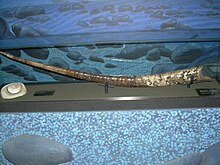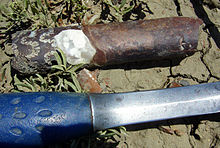Baculites
| Baculites Temporal range: Upper Cretaceous
| |
|---|---|

| |
| Baculites fossils from South Dakota. Some still have traces of the original nacre (shells). | |
| Scientific classification | |
| Kingdom: | |
| Phylum: | |
| Class: | |
| Order: | |
| Suborder: | |
| Superfamily: | |
| Family: | |
| Genus: | Baculites Lamarck, 1799
|
| Type species | |
| Baculites vertebralis | |
| Species | |
|
See text | |
Baculites ("walking stick rock") is an extinct genus of cephalopods with a nearly straight shell, included in the heteromorph ammonites. The genus, which lived worldwide throughout most of the Late Cretaceous, was named by Lamarck in 1799.[3]

The adult shell of Baculites is generally straight and may be either smooth or with sinuous striae or ribbing that typically slant dorso-ventrally forward. The aperture likewise slopes to the front and has a sinuous margin. The venter is narrowly rounded to acute while the dorsum is more broad. The juvenile shell, found at the apex, is coiled in one or two whorls and described as minute, about a centimeter in diameter. Adult Baculites ranged in size from about seven centimeters (Baculites larsoni) up to two meters in length.
As with other ammonites, the shell consisted of a series of camerae, or chambers, that were connected to the animal by a narrow tube called a siphuncle by which gas content and thereby buoyancy could be regulated in the same manner as Nautilus does today. The chambers are separated by walls called septa. The line where each septum meets the outer shell is called the suture or suture line. Like other true ammonites, Baculites have intricate suture patterns on their shells that can be used to identify different species.
One notable feature about Baculites is that the males may have been a third to a half the size of the females and may have had much lighter ribbing on the surface of the shell.
The shell morphology of Baculites with slanted striations or ribbing, similarly slanted aperture, and more narrowly rounded to acute keel-like venter points to its having had a horizontal orientation in life as an adult. This same type of cross section is found in much earlier nautiloids such as Bassleroceras and Clitendoceras from the Ordovician period, which can be shown to have had a horizontal orientation. In spite of this, some researchers have concluded that Baculites lived in a vertical orientation, head hanging straight down, since lacking an apical counterweight, movement was largely restricted to that direction. More recent research, notably by Gerd Westermann, has reaffirmed that at least some Baculites species in fact lived in a more or less horizontal orientation.[4]
From shell isotope studies, it is thought that Baculites inhabited the middle part of the water column, not too close to either the bottom or surface of the ocean. In some rock deposits Baculites are common, and they are thought to have lived in great shoals. However, they are not known to occur so densely as to be rock-forming, as do certain other extinct, straight-shelled cephalopods (e.g., orthocerid nautiloids).
Baculites fossils are very brittle and almost always break. They are most commonly found broken in half or several pieces, usually along suture lines. Individual chambers found this way are sometimes referred to as "stone buffaloes" (due to their shapes), though the Native-American attribution typically given as part of the story behind the name is likely apocryphal.[clarification needed] The Blackfoot have oral traditions that tell a story of the Iniskimm (Buffalo Calling Stone). They are still in use today by Indigenous peoples.
Baculites and related Cretaceous straight ammonite cephalopods are often confused with the superficially similar orthocerid nautiloid cephalopods. Both are long and tubular in form, and both are common items for sale in rock shops (often under each other's names). Both lineages evidently evolved the tubular form independently, and at different times in earth history. The orthocerid nautiloids lived much earlier (common during the Paleozoic Era and extinct by the end of the Triassic Period) than Baculites (Late Cretaceous Period only). The two types of fossils can be distinguished by many features, most obvious among which is the suture line: it is simple in orthocerid nautiloids and intricately folded in Baculites and related ammonoids.
Studies[5] on exceptionally preserved specimens have revealed a radula by synchrotron imagery. The results suggest that Baculites fed on pelagic zooplankton (as suggested by remains of a larval gastropod and a pelagic isopod inside the mouth).[6]
Species distribution



The type species, Baculites vertebralis is from the upper Maastrichtian, Upper Cretaceous, and is one of the last of its kind.
The lower part of the Campanian stage (Upper Cretaceous) in the Western Interior of North America has yielded Baculites gilberti, early B. perplexus, B. asperiformis, B. maclearni, and B. obtusus, followed temporally by late Baculites perplexus and then by Baculites scotti. The upper part of the upper Campanian has yielded, from older to younger, B. compressus, B. coneatus, B. reesidei. B. jenseni, and B. ellasi, followed sequentially in the lower Maastrictian by Baculites baculus, B. grandis, and B. clinolobatis.[7][8]
Baculites gracilis is known from the Cenomanian Britton Fm., Eagle Ford group of Texas; Baculites ovatus from the eastern U.S.[9] and Baculites pacificum from the Campanian of Vancouver Island, British Columbia.
Species known from Europe, in addition to Baculites vertebratis include Baculites undulatus from the upper Touronian,[10] Baculites leopoliensis from the Upper Campanian and Baculites anceps from the Upper Maastrictian.[11]
References
- ^ Lamarck, J. P. B. A. de M. de (1801): Systeme des Animaux sans vertebres. The author; Deterville, Paris, vii + 432 pp.
- ^ Meek, F. B. (1876): A report on the invertebrate Cretaceous and Tertiary fossils of the upper Missouri country. In Hayden,F. V. Report of the United States Geological Survey of the Territories, 9, lxiv + 629 pp., 45 pis
- ^ Lamarck, J. P. B. A. de M. de (1799): Prodrome d'une nouvelle classification des coquilles. Mem. Soc. Hist. Nat.Paris, (1799), 63-90.
- ^ Westermann, G. E. G. 1996. Ammonoid life and habitat. In N. H. Landman, K. Tanabe, and R. A. Davis (editors), Ammonoid Paleobiology, pp. 607–707. New York: Plenum Press.
- ^ Kruta, I.; Landman, N.; Rouget, I.; Cecca, F.; Tafforeau, P. (2011). "The Role of Ammonites in the Mesozoic Marine Food Web Revealed by Jaw Preservation". Science. 331 (6013): 70–72. Bibcode:2011Sci...331...70K. doi:10.1126/science.1198793. PMID 21212354.
- ^ Neil H. Landman, Neal L. Larson and William A. Cobban (2007). Chapter 13. Jaws and Radula of Baculites from the Upper Cretaceous (Campanian) of North America. In N. H. Landman et al. (eds.), Cephalopods Present and Past: New Insights and Fresh Perspectives Archived 2013-02-02 at the Wayback Machine, 257–298. © 2007 Springer.
- ^ Cretaceous Fossil Zones
- ^ Baculitidae jdsamonites
- ^ Mesozoic Cephalopods
- ^ Ammonites in Ammonites et autres fossiles
- ^ Baculitidae
- Arkell et al., 1957, Mesozoic Ammonoidea, Treatise on Invertebrate Paleontology Part L. Geological Soc. of America, Univ of Kansas Press. R.C. Moore, (Ed)
- W. A. Cobban and Hook, S. C. 1983 Mid-Cretaceous (Turonian) ammonite fauna from Fence Lake area of west-central New Mexico. Memoir 41, New Mexico Bureau of Mines&Mineral Resources, Socorro NM.
- W. A. Cobban and Hook, S. C. 1979, Collignoniceras woollgari wooollgari (Mantell) ammonite fauna from Upper Cretaceous of Western Interior, United States. Memoir 37, New Mexico Bureau of Mines&Mineral Resources, Socorro NM.
- Ammonitida genera
- Turrilitoidea
- Late Cretaceous ammonites
- Late Cretaceous cephalopods of North America
- Late Cretaceous genus first appearances
- Late Cretaceous genus extinctions
- Paleozoic life of Africa
- Paleozoic life of Asia
- Paleozoic life of Australia
- Paleozoic life of Europe
- Paleozoic life of North America
- Paleozoic life of Oceania
- Paleozoic life of South America
- Paleozoic life of Alberta
- Paleozoic life of British Columbia
- Paleozoic life of Saskatchewan
- Fossils of Angola
- Fossils of Antarctica
- Fossils of Argentina
- Fossils of Australia
- Fossils of Austria
- Fossils of Belgium
- Fossils of Brazil
- Fossils of Canada
- Fossils of Chile
- Fossils of Denmark
- Fossils of Egypt
- Fossils of France
- Fossils of Germany
- Fossils of Greenland
- Fossils of Haiti
- Fossils of India
- Fossils of Japan
- Fossils of Jordan
- Fossils of Mexico
- Fossils of Mozambique
- Fossils of the Netherlands
- Fossils of New Zealand
- Fossils of Nigeria
- Fossils of Romania
- Fossils of Russia
- Fossils of South Africa
- Fossils of Spain
- Fossils of Sweden
- Fossils of Tajikistan
- Fossils of Tunisia
- Fossils of Turkey
- Fossils of Turkmenistan
- Fossils of the United Kingdom
- Fossils of the United States
- Fossils of Uzbekistan
- Fossils of Venezuela
- Fossil taxa described in 1799
- Taxa named by Jean-Baptiste Lamarck
